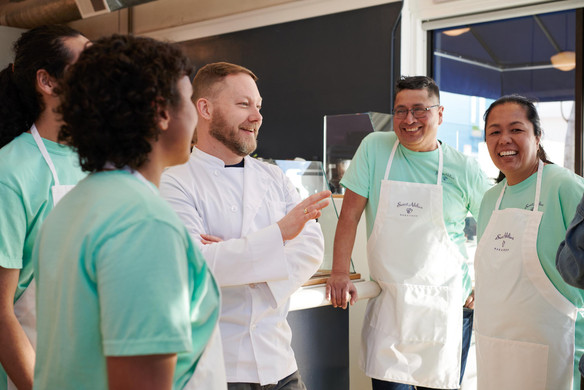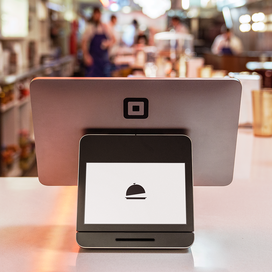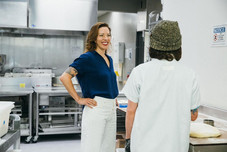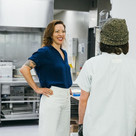Table of contents
No job is too big or too small for restaurant operators. NaanStop owner Samir Idnani flexes between serving guests, marketing the business, scheduling, cleaning and catering. “As a business owner, you step in to do whatever is needed whenever it is needed,” he explained on our podcast.
But as you grow your restaurant business, delegating specific responsibilities across a leadership team becomes essential for long-term success. Poor restaurant leadership is cited as a top reason why many restaurants fail early on. And building a restaurant leadership team is critical to keeping operations running and staff from churning. Many staffers have flocked to other industries over the last few years in part due to lack of stability, which has contributed to an ongoing labor shortage.
With a restaurant leadership team in place, you don’t only give yourself more time to focus on big-picture goals, like launching another location or evolving your business with new revenue streams, you also give your team the opportunity to grow in their career at a time when retaining staff is critical.
Whether you’re just starting to think about leadership at your restaurant or evaluating the framework you have in place, here are some key elements to consider when creating leadership positions, hiring staff, and onboarding technology that empowers your leaders to smoothly run everything.
Fundamental roles of a restaurant leadership team
The model of your restaurant and the services you offer will determine the leadership roles your restaurant needs, and this may change as your business grows and evolves. Maybe like The Laya Center — a wellness center that also operates a tea bar — you run a food and beverage operation along with a service offering. Or perhaps, like Taziki’s Mediterranean Café, you own a multi-location, fast-casual restaurant.
No matter the type of restaurant you run, your leadership team starts with you — the owner. Start identifying the roles you need by documenting your own responsibilities, from overseeing staffing and administration decisions to maintaining inventory or handling payroll. This exercise can also help you determine which tasks you’d like to dedicate more time towards and which responsibilities you can hand off to a general manager or another leader.
Quick-service and fast-casual restaurant leadership
At quick-service and fast-casual restaurants, where meals are prepared and served efficiently and table service is limited, you may have a general manager, an assistant manager, and a kitchen manager. Several different businesses, from cafes and coffee shops to sandwich delis and burger joints, can fall within these categories.
- A general manager is second in command to the owner. They are typically responsible for leading the assistant and kitchen managers while overseeing food quality, training staff, and acting as a liaison between the back-of-house leadership and owner. Due to the high level of daily interaction the general manager has with other staff, the GM is an influential position that plays a role in the overall success of the business. That’s why your GM should be emotionally intelligent, have empathy for other staff and guests, and possess strong collaboration and communication skills, according to Jay Bandy, president of Goliath Consulting Group, in a recent interview with Nation’s Restaurant News.
- Depending on the size of your business and staff, you may also onboard an assistant manager to support the general manager with duties like managing customer reservations, asking for customer feedback and resolving complaints. Some assistant managers also handle payroll and are responsible for reporting insights to the owner for assessing expansion opportunities.
- A kitchen manager is often responsible for handling the duties associated with the back of house, like managing ingredient inventory, creating schedules for kitchen staff, and maintaining cleanliness and sanitation standards. Because of this, kitchen managers often require culinary knowledge, interpersonal skills, and a strong attention to detail.
Full-service and fine-dining restaurant leadership
At full-service restaurants or fine-dining establishments, where guests are seated via a host and they place their orders with servers, there can be even more leadership positions required. In addition to a general manager, assistant manager, and food and beverage or kitchen manager, you might onboard the following back-of-house leadership roles.
- An executive or head chef, who, in collaboration with the kitchen manager, develops the menu and prepares food. Often, a head chef will hire and train kitchen staff, oversee quality, and expedite food to keep orders steadily flowing from the kitchen to guests. This means, in addition to culinary training, head chefs possess experience managing kitchen operations, training staff, and collaborating with multiple different personalities and roles.
- If your restaurant serves alcohol, whether fully functioning as a bar or brewery or simply as part of a full-service menu, you might also enlist a bar manager to manage bar inventory, create new drinks, and purchase liquor. Sommeliers are another type of leader you might consider, depending on your restaurant, who is responsible for managing wine lists, creating pairings with your chef, and advising guests on selection. Both of these positions can require special training. And because they speak directly with guests and other vendors, they should have strong customer service and communication skills.
Empower your restaurant leadership team with the right technology.
After assessing your restaurant’s leadership needs, your team can scale quickly. This can be a good opportunity to evaluate the tools and technology you have in place that support your leadership team and staff and empower them to run things more autonomously.
Square staffing solutions range to include Payroll, Shifts, Team Communication, Team Management and HR management software, HR Experts. With Square Team Management, you can give all staff access to your POS software, enabling them to clock in and out and perform daily responsibilities. You can also adjust permissions based on leadership roles, so your leadership team has visibility into daily reports, including sales trends, that they can surface to you regularly.
Square Team Management also integrates with our HR software, HR Experts powered by Mineral. This platform provides you with guidance regarding HR laws and compliance, offers templates for HR documentation and policies, gives you access to HR professionals and more.
Today, 31% of recently surveyed restaurant owners say they’ve been under staffed for over two years. At the same time, the majority (88%) of restaurant operators say they plan to grow and expand their offerings this year. While demand for restaurant professionals stays high, it’s critical for operators to provide more ease and opportunity to employees. By creating leadership positions and enabling managers to thrive in their roles, owners will be better equipped to achieve their goals with a team they can count on.
![]()












